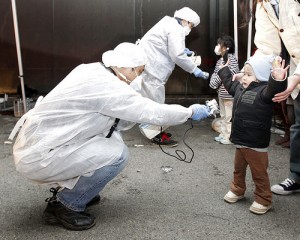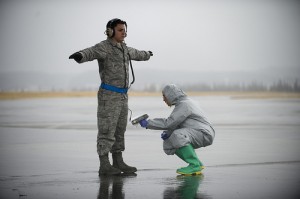Posted on 15 April 2011. Tags: chief cabinet secretary, evacuation zone, geological survey, magnitude earthquake, nuclear reactors, pregnant women, radiation exposure, state television, tokyo electric, yukio
 Japan widened its evacuation zone surrounding the quake-hit nuclear power plant due to increased levels of radiation, which have had accumulated, as a strong aftershock hit the area on Monday, a month after the devastating incident occurred.
Japan widened its evacuation zone surrounding the quake-hit nuclear power plant due to increased levels of radiation, which have had accumulated, as a strong aftershock hit the area on Monday, a month after the devastating incident occurred.
Tokyo and eastern part of Japan was shook with a 7.1 magnitude earthquake on Monday evening, which then triggered a small tsunami alert. State television said the aftershock caused an off-site power supply for the damaged reactors to shut down.
Geological survey conducted by the United States said that the aftershock hit 38 kilometers (24 miles) west of the Iwaki city at a depth of 14 kilometers (8 miles).
Workers at Tokyo Electric Power Co had ceased pouring cooling waters on reactors no. 1, 2 and 3 at the Fukushima power plant.
Families living in towns and villages outside the 20 kilometer evacuation zone, where more radiation have had accumulated, would be evacuated, according to Chief Cabinet Secretary Yukio Edano. He said hospitalized patients, children and pregnant women should avoid the area within 20-30 kilometers from the Fukushima complex.
Also, Edano said that the decision to expand the evacuation area was based on the data analyzed from the accumulated radiation exposure information. He said the evacuation precautions are meant to secure the safety of the people who might live in the area for 6 months to one year. However, it is not necessary to evacuate immediately, he added.
Previously, Japan did not agree to the proposed plans to extend the evacuation zone despite concerns from neighboring countries regarding the radiation that might spread from the damaged nuclear reactors at Fukushima.
Posted in Nation and World
Posted on 30 March 2011. Tags: acute radiation syndrome, armed forces radiobiology research, armed forces radiobiology research institute, critical gap, hartl, medical field, nuclear power plants, nuclear problems, radiation exposure, world health organization
 The nuclear problems in Japan emphasize one critical gap in the medical field- experts only have had a few proven ways to help treat people who have already been exposed to massive amounts of radiation.
The nuclear problems in Japan emphasize one critical gap in the medical field- experts only have had a few proven ways to help treat people who have already been exposed to massive amounts of radiation.
Last week, two workers from Japan’s nuclear power plants were hospitalized due to radiation burns. Low levels of radioactive iodine were reported, Tuesday, at some areas in southeastern China. Some traces were also discovered in Seoul to as far as Britain and eastern United States.
The crisis in Japan raises concern among people as to how radiation emergencies can be effectively treated. Some experts are already developing drugs that will treat radiation poisoning, as well as the first tests that will determine who among the exposed people would need rapid treatment.
However, these possibilities are still in preparation, and not yet ready.
In the United States, radiobiology laboratories such as the Armed Forces Radiobiology Research Institute are now in search for more methods to treat people against radiation exposure. The laboratory is working with Oncova Company to develop one possible treatment called Ex-Rad.
Since 2008, the Biomedical Advanced Research and Development Authority have invested millions for radiation testing and anti-radiation treatment.
Currently, only a few are proven effective for radiation injuries. These include antibiotic therapy, providing blood-clotting platelets and hydration therapy for acute radiation syndrome, as well as overall poisoning.
Potassium iodide is usually given to prevent long-term effects. However, World Health Organization advises the public not to drink the pills unless health officials recommend them to. Gregory Hartl, WHO spokesman, says the drug has its risks.
Posted in Health
 Japan widened its evacuation zone surrounding the quake-hit nuclear power plant due to increased levels of radiation, which have had accumulated, as a strong aftershock hit the area on Monday, a month after the devastating incident occurred.
Japan widened its evacuation zone surrounding the quake-hit nuclear power plant due to increased levels of radiation, which have had accumulated, as a strong aftershock hit the area on Monday, a month after the devastating incident occurred.
 The nuclear problems in Japan emphasize one critical gap in the medical field- experts only have had a few proven ways to help treat people who have already been exposed to massive amounts of radiation.
The nuclear problems in Japan emphasize one critical gap in the medical field- experts only have had a few proven ways to help treat people who have already been exposed to massive amounts of radiation.